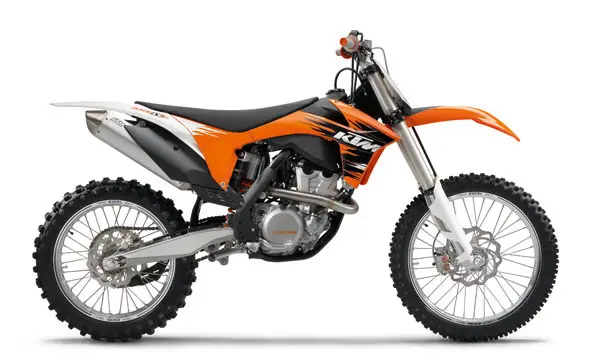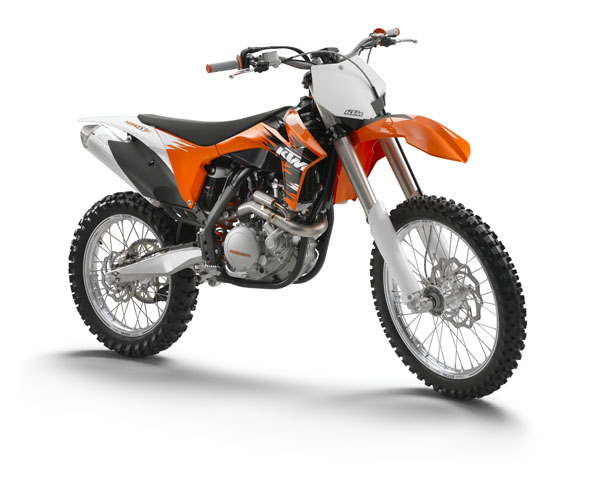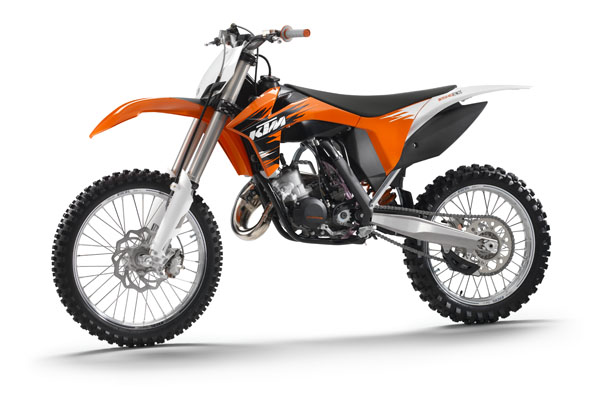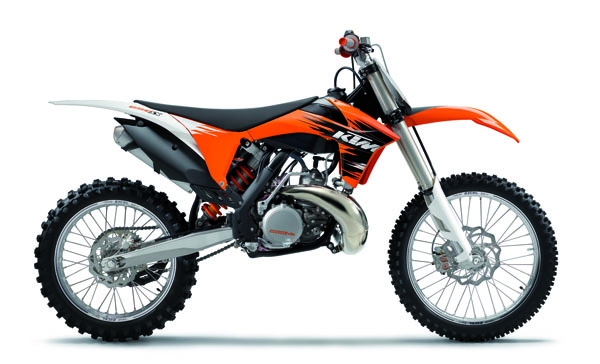NEXT YEAR’S BIKES TODAY! FIRST LOOK AT THE 2011 KTM MOTOCROSS BIKES:

The 2011 KTM 350SXF will soak up the media limelight for the next model year. Mike Alessi will race the hybrid in the AMA 450 Nationals, starting this weekend at Hangtown.
[Press Release from KTM]
The new SX generation contains the concentrated know-how of a highly modern Development department combined with the knowledge of a racing department which has been very successful for many years and led by ten-time World Champion Stefan Everts.
Since the beginning of development of the 350 SXF, Stefan was at the leading edge and stamped his baby from the very first sketch until the final serial settings. His ambitious aim was, to lift the motocross topic to a new, previously unreached level with the 350SXF and therefore build the ultimate winning bike for the motocross future. Through the cooperation of Stefan Everts and KTM, a new milestone in motorcycle development has been set.
The lightweight 350 SXF with extremely compact DOHC engine makes the perfect weapon for every motocross use. Performance close to the 450cc motocrosser means no loss at starts or during acceleration, handling that is close to the 250cc bikes due to compact measurements and low gyroscopic masses.
With this combination of powerful power delivery and playful handling the rider benefits more, the longer a race goes on ? no matter if professional or beginner. Additional ingredients like electric start and electronic fuel injection make the 350SXF the ultimate contender for the 450 class.
KTM has experience in building sport motorcycles for more than 55 years. This shows the highest level of experience in developing race bikes. 170 World Championship titles prove this.
2011 CHASSIS

Frame
Completely new frames, made of modern lightweight chromoly steel material in various profiles. Compared to our previous SX frames the 2011 frame design provides higher torsional and reduced longitudinal stiffness. In addition it is designed to absorb energy created from the rear wheel impacts. This new design benefits both the PDS of the new two-strokes and Pro-Lever linkage rear suspension of the four-strokes. The basic frame designs are pretty much the same. The main difference between PDS and linkage is the tower of the upper shock mount, which for both systems, takes the main role to isolate the shock absorber forces from the frame.
To the aluminum frame trend of our competitors, we have delivered a high-tech steel frame that weighs less than the lightest competitor. In addition it is easier to maintain, easier to work on and supplies more space for the tank and other components.
Rear Suspension
KTM has proven that the PDS rear suspension system is capable of winning any motocross race. But ,when it comes to Supercross, the PDS becomes more critical in regards to bike set-up. KTM’s new linkage provides a better solution to the increased loading demands that extreme Supercross requires and covers a wider range of circuits.
Both systems have a certain rising rate, which means that when the rear wheel moves at a constant rate, the rate of the shock shaft increases, or in other terms, if the rear wheel travels at a constant velocity, the shock shaft is accelerating. The difference between the two systems is with PDS the shaft velocity does not increase as much as with linkage. The PDS system creates additional damping with internal systems in the shock, and as a result, both the linkage and PDS system produce similar dampening characteristics. The main difference lies in the fact that the PDS system provides a more linear spring progression than the linkage system. The PDS character is extremely beneficial for the lighter two-stroke bikes and to offroad applications, whereas a high-spring progression in the linkage system benefits the extreme Motocross and Supercross applications.
Shock
PDS 2011: Longer PDS shock to offer an improved rising-rate character.
Linkage: Completely new WP unit with piston and bushings that provide better seal and friction properties to handle the higher shaft velocities.
Both shocks also have a new spring retention and preload system to allow for preload adjustment without the use of hammer and punch.
A wide range of adjustability of rebound and high/-low speed compression damping are KTM standard anyway.
Why PDS for the two-strokes?
The directly linked PDS shock has turned out to be the best solution for the two-strokes. Two-Strokes have a totally different engine characteristic than four-strokes and also a different centre of gravity. Many tests have proven that the PDS rear suspension fits better to the lighter and more nervous characteristics of the two-strokes. With the lighter PDS system, the two-strokes will keep a major weight benefit, also in the future.
Will PDS remain for the EXC line-up?
Yes ? no doubt about it! The majority of the Enduro applications benefits from the more linear spring progression of the PDS. In addition, it provides a better ground clearance, less maintenance, less weight and easy access to remove the shock from the bike within a few seconds.
Swingarm
There are new, cast aluminum swingarms for both the PDS and the linkage-equipped bikes. The single-component casting process allows unlimited geometry solutions and eliminates any inconsistencies created by welding. Updated mounting positions, higher profiles and optimized flex are supporting the frame and suspension characteristics.
Front Suspension
All SX models are fitted with the latest generation of 48 mm USD front forks “made by WP in Austria.” Due to intense development in the recent years the “WP closed cartridge technology” has been fine-tuned for excellent sensitivity and damping characteristics, which has been proven in many shootouts of the last season. For MY 2011 new settings for each model match perfectly the needs of new chassis packages. Due to an internal closed damping cartridge these forks create more consistent damping characteristics in extreme use situations than open cartridge systems.
Triple Clamps
The KTM patented SX triple clamps can be called “works of art.” CNC-machined out of high quality aluminum billet, the sophisticated design and clamping system avoids squeezing of the tubes, while supporting the fork’s action. In addition, the design provides a certain flex, which allows the triple clamps to follow the fork legs when deflected during hard landing or braking.
Bodywork
According to KTM’s philosophy, “design follows function.” Thus the KTM engineers put highest priority on rider ergonomics. And, in this respect, Stefan Everts took a key roll during the entire development process. Who could know the needs of a motocrosser better than a ten-time Motocross World Champion? From the first clay model till the final product Stefan was heavily involved with each step of the development and he really pushed the design team of Kiska until every single detail was addressed in order to get the ideal shape of a future champions bike. The results are super slim ergonomics and a bodywork with excellent contact points between rider and machine. He also insisted on having a wider and 50 mm longer rear fender. And not to forget features like the no-tools access to the air filter or the incorporated lift handle in the outer rear fender, which is well protected against dirt from the rear wheel.
Airbox
The new layout of the airbox was driven by two main functions: optimised protection for the air filter against dirt and a maximum airflow for maximum performance. Due to the special design between filter and intake throttle body, the airbox was designed separately for every displacement and improves the power significantly. The ability to change the large Twin-Air filter quickly and without tools is the KTM standard and outstanding in the motocross world.
Wheels
Weight reduced high-quality wheels with CNC-machined hubs and high-end Excel rims are hard to beat. They are the standard in terms of durability.
New silver rims not only appear lighter, they also take the unavoidable damages during tire changes much better than rims coated in any other color. Spokes are now covered with a noble zinc/nickel coating which not only suits the silver rims optically, but also has an improvement regarding corrosion resistance. New nipples made of high-strength aluminum the weight could be reduced again, which is an important feature supporting suspension action and easy handling.
Exhaust silencer
The four-strokes have new improved silencers that score points with a modern and voluminous profile not only optically but also reducing the noise level to future noise emission regulations (115dB for the two-meter Max test). A bigger outlet diameter improves the performance and delivers a sound improvement.
New silencers for two-stroke bikes introduce a new “two-component” technology. A strong plastic holder is injection-molded around the aluminium housing to attach the silencer to the motorcycle better.
Cooling System
The proven integrated cooling system routes from the cylinder head through the frame triangle directly to the radiators, the removed tubing simplifies the radiator mounting and improves the air flow through the radiators. A new T-connector with an optimised fluid flow improves the heat dissipation.
Tank
The slim 7.5-liter tank made from lightweight polyethylene includes a compact fuel pump on the 250 and 350SXF models. All other models introduce a new fuel tank with the same capacity as well. The well proven ¬-turn fuel cap allows easy and quick refilling and includes a security against unwanted turning.
Brakes
Brakes by Brembo are serial equipment of KTM models and are combined with lightweight wave rotors which are the benchmark when it comes to feel and brake performance.
Other equipment ? highest level
There are many features on the new SX which highlight the KTM at first appearance against its competitors. For example, the comfortable hydraulic clutch, tapered Renthal handlebar or CNC-machined triple clamps, Twin Air air filter, high grade chain and sprockets, Also smaller details like foot brake lever with a high quality bearing
2011 KTM 250SXF

The 250SXF is nearly a guarantee for top positions in hard fought Motocross-events. That is proven by numerous top places at the 250 World championship. Already known for its strong performance, the new generation presents itself with a further developed, stronger engine including fuel injection and the option to include an electric start with small effort. The new 250 SXF will remain a winning bike that will be hard to follow for the competitors.
Cylinder head
The heart of the very compact engine is the brilliant cylinder head with two overhead camshafts and DLC-coated finger followers. A fluidic developed intake channel guarantees more flow and therefore increased performance.
Camshafts
Newly developed camshafts with a new valve timing are tailored to improve the intake charge thanks to the new intake port, shape of intake boot (between throttle body and air filter) and the new exhaust. The new cams supply a better the cylinder filling and therefore improve the torque and performance delivery.
Exhaust system
A newly dimensioned exhaust header combined with the new silencer with bigger outlet diameter lead to a better flow and improved performance.
Ignition
The new 250SXF engine has an AC generator with bigger capacity which runs in oil. This new generator secures enough energy for the fuel injection system and allows the retrofitting of an electric start system.
Starter
The new 250SXF engine is available in serial production with a kick starter-only to keep the weight at a minimum level. A new capacitor (attached to the throttle body) in combination with the fuel injection system ensures that the bike can be started easily and safely without a battery.
Additionally the new engine gives the option, to retrofit an electric start system with small effort. An E-start kit with starter, ignition cover, gears, battery and wiring will be available from KTM’s Power Parts program.
Engine Management System (EMS)
The newly developed engine management system by Keihin with electronic fuel injection and 42mm throttle body secures spontaneous and powerful response and maximum performance. Comfortable temperature and sea level compensation as well as the automated cold start system are state of the art. An optional map select switch (PowerParts) activates additional engine characteristics by the click of a switch. Additionally the user setting tool (PowerParts) allows the logging of data of the bike with a laptop and to change the mapping by few mouse clicks.
2011 KTM 350SXF

Ultra-compact four-stroke engine with modern electronic fuel injection and electric start. The extremely short stroke 349.5cc DOHC engine with 57.5mm stroke and 88mm bore has a very wide usable speed range, top performance and very efficient rideability. The layout of the 350 engine is close to the 250SXF engine and has bigger dimensions at nearly the same weight. The playful handling (similar to a 250 engine) results mainly from reducing the rotational masses to a minimum.
DOHC cylinder Head
Four ultra-lightweight titanium valves in combination with DLC-coated finger followers allow a high rpm limit of 13,000 rpm. Herewith the engine can deliver enough power to win every holeshot.
Valve Train
The crankshaft turns an intermediate gear, which drives the cam chain and at the same time acts as balancer shaft and holds the water pump. A hydraulic cam chain tensioner secures a reliable tension of the chain and therefore precise cam timing.
E-Start
A few years ago KTM proved that an electric start in motocross is of great advantage. Therefore, the new 350SXF can also be started easily by the press of a button. For non-believers in the this technology the 350SXF has an option to retrofit a kickstarter to the bike.
Following starting variations are possible:
A: Only E-start (series)
B: E-start plus Kickstart
C: Only Kickstart

Engine Management System (EMS)
The newly developed engine management system by Keihin with electronic fuel injection and 42mm throttle body secures spontaneous and powerful response and maximum performance. Temperature and sea level compensation as well as the automated cold start system are state of the art. An optional map select switch (PowerParts) activates additional engine characteristics by the click of a switch. Additionally the user setting tool (PowerParts) allows the logging of data of the bike with a laptop and to change the mapping by few mouse clicks.
Balancer shaft
For balancing the rotational masses, the 350SXF engine has a balancer shaft on the right side of the engine which acts at the same time as a water pump intermediate gear and drive pinion gear for the camshaft. This solution secures a very compact overall design of the engine.
Transmission and clutch
The newly developed five-speed gearbox was designed to suit the engine characteristic of the 350SXF and shines with a very precise shifting. The hydraulic clutch by Brembo guarantees a light operation and good controllable modulation of the clutch.
Lubrication system
The new 350SXF engine has two oil pumps similar to the 250SXF engine. A pressure pump supplies the crankshaft, piston and valve train. Additionally it supplies lubrication for the clutch and cools the ignition. A suction pump evacuates the crank housing and lubricates the gear box. This creates a vacuum in the crank housing to increase the engine performance.
2011 KTM 450SXF

If asked for maximum power there is no other way but the 450SXF. For years this bike is the synonym for maximum power and Max Nagl shows his exhaust to the competitors. The well proven DOHC engine has only slight changes, as it was continuously developed over the last few years and could win numerous shoot outs. The package for 2011 with a new chassis will be able to play its strengths even better.
Carburetor
The engine of the 450SXF is powered by a Keihin FCR flat throttle 41mm carburetor . The integrated acceleration pump secures a spontaneous and powerful performance.
Clutch
The 2010 refined clutch has a strengthened design of the basket and can withstand the high power delivery of this engine. The hydraulic clutch operation is of the highest KTM standard as well.
Gearbox
The five-speed gearbox developed for 2010 was well accepted on the market. The slightly closer ratios between the gears suits most of the tracks perfectly. The five-speed gearbox is an essential part for the good results in the comparison tests.
Exhaust header
The superlight titanium exhaust header pipe and the innovative Header Pipe Resonator System (HPRS) guarantee, in combination with the new rear silencer, top engine performance at very low noise level.
E-Starter
The fact that an electric start can be of enormous advantage during a motocross heat has spread around and was highlighted at all shoot outs. The minimal disadvantage of 1.5 Kg weight increase is less problematic than the loss of positions when the bike has to be restarted by kickstart after a minor slip-up. Stefan Everts was skeptical at the beginning, but today he states, “I would not want to ride a bike without E-start again, doesn’t matter if at racing or just for fun!“
2011 KTM 150SX

The perfect combination of playful handling of a 125 and engine power close to a 250 four-stroke. In many countries the 150SX can be raced in MX2 class and becomes increasingly an alternative for all who like the easiest handling and reasonable costs.
New for 2011:
new Chassis (PDS)
improved rear silencer
new airbox
air flow optimised intake boot between filter and carburettor
noticeable increase in power performance
2011 KTM 250SX

For years KTM has committed to the development of two-stroke engines which are an advantage against four-strokes in many aspect. Unbeatable is the power-to-weight ratio, lower cost of acquisition and maintenance, and simple to service and rebuild, which allows a piston change without having studied engineering.
New for 2011:
new chassis (PDS)
new airbox
air flow optimised intake boot between filter and carburettor
new exhaust (new shape, bigger diameter at connection pipe)
new two-component rear silencer (better connection, bigger inner diameter)
newly developed cylinder (lower exhaust port, new timings, optimised exhaust control)
noticeable increase in power performance
higher torque
better rideability




Comments are closed.